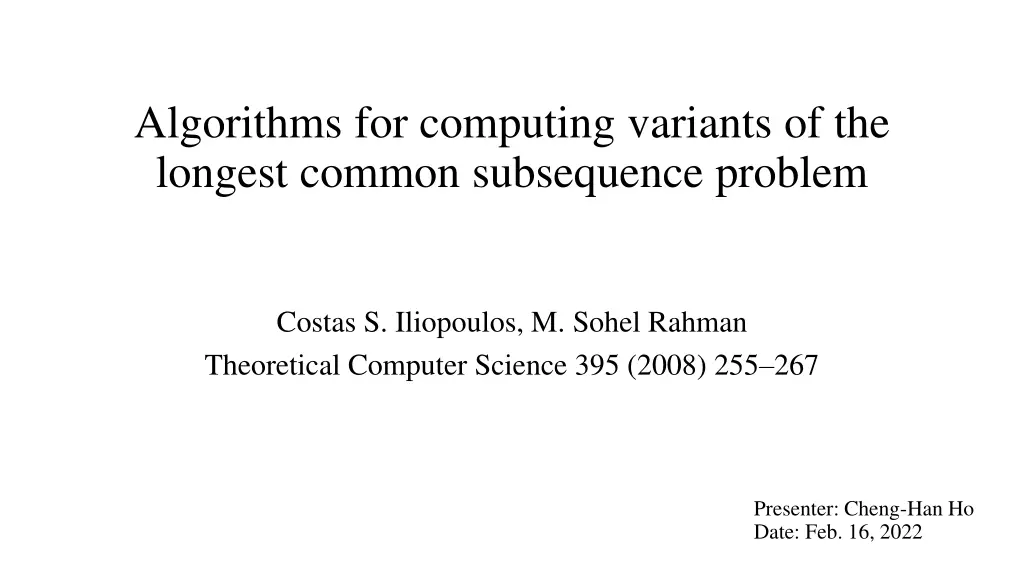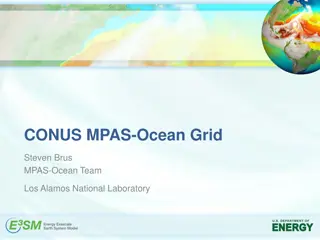
Efficient Algorithms for Longest Common Subsequence Variants
Explore new variants of the longest common subsequence (LCS) problem and efficient algorithms to solve them, including fixed gap constraints and rigidness. The study introduces novel techniques to improve running time, handle elastic and rigid gaps, and extend results for strings of different lengths.
Download Presentation

Please find below an Image/Link to download the presentation.
The content on the website is provided AS IS for your information and personal use only. It may not be sold, licensed, or shared on other websites without obtaining consent from the author. If you encounter any issues during the download, it is possible that the publisher has removed the file from their server.
You are allowed to download the files provided on this website for personal or commercial use, subject to the condition that they are used lawfully. All files are the property of their respective owners.
The content on the website is provided AS IS for your information and personal use only. It may not be sold, licensed, or shared on other websites without obtaining consent from the author.
E N D
Presentation Transcript
Algorithms for computing variants of the longest common subsequence problem Costas S. Iliopoulos, M. Sohel Rahman Theoretical Computer Science 395 (2008) 255 267 Presenter: Cheng-Han Ho Date: Feb. 16, 2022
Abstract (1/2) The longest common subsequence (LCS) problem is one of the classical and well-studied problems in computer science. The computation of the LCS is a frequent task in DNA sequence analysis, and has applications to genetics and molecular biology. In this paper we introduce new variants of LCS problem and present efficient algorithms to solve them. In particular we introduce the notion of gap constraints in the LCS problems. For the LCS problem with fixed gap, we first present a naive algorithm runs in O(n2+ R(K + 1) 2) time, where R is the total number of ordered pairs of positions at which the two strings match and K is the fixed gap constraint. We then improve the running time to O(n2+ RK + R log log n) using some novel techniques.
Abstract (2/2) Furthermore, we present an algorithm that is independent of K and runs in O(n2+ R log log n) time. Using these techniques, we also present a new O(n2) algorithm to solve the original LCS problem. Additionally, we modify our algorithms to handle elastic and rigid gaps. We also apply the notion of rigidness to the original LCS problem and modify the traditional dynamic programming solution to handle the rigidness presenting a O(n2) algorithm to solve the problem. Finally, we also improve the solution to Rigid Fixed Gap LCS to O(n2). Notably, in all of the above cases, we assume that the two given strings are of equal length i.e. n. But our results can be easily extended to handle two strings of different length.
FIG (LCS Problem with Fixed Gap) X = ABCCDEFGACD Y = AFCGFCABD Let S = LCS(X, Y) = ACFAD when K = 1, S is not FIG when K = 2, S is FIG
K+1 FIG Y1 Y2 ... Yj-1-K Yj-1 Yj Yn match (K + 1)2 R matches O(n2+ R(K + 1) 2) X1 X2 Xi-1-K K+1 Xi-1 Xi Xn
An improved algorithm for FIG reduce (K + 1)2 to (K + 1) n vEB (K+1) Xi = Yj (K+1) vEB Y1 Y2 ... Yj-1-K Yj-1 Yj Yn X1 X2 Xi-1-K Xi-1 Xi Xn
vEB (Van Emde Boas tree) maintain a sorted list of integers in the range [1..n] insert & delete: O(log log n) find_next & find_previous : O(1) find_maximum : O(1)
An improved algorithm for FIG Step.1: match pairs Step.2: match Step.3: n vEB
An improved algorithm for FIG Step.1: match pairs O(R log log n2) = O(R log log n)
An improved algorithm for FIG Y1 Y2 ... Yj-1-K Yj-1 Yj Yn Step.2: match X1 X2 Xi-1-K Xi-1 Xi Xn
An improved algorithm for FIG Y1 Y2 ... Yj-1-K Yj-1 Yj Yn Step.3: n vEB X1 X2 Xi-1-K Xi-1 Xi Xn
An improved algorithm for FIG O(n2+ R(K + 1) 2) => O(n2+ RK) maintaining vEB: O(R log log n) FIG can be solved in O(n2+ RK + R log log n)
A K-independent algorithm for FIG RMAX (Range Maxima Query Problem) Suppose that we are given a sequence A = a1a2 an A Range Maxima (minima) Query specifies an interval I = (is, ie), 1 is ie n and the goal is to find the index with maximum (minimum) value amfor am I. solved in O(n) pre-processing time and O(1) time per query O(n2+ RK + R log log n) => O(n2+ R log log n)
RLCS (Rigid LCS Problem) 1 2 3 4 5 6 7 8 X = FCGFCABD Y = FGACD RLCS = FAD FA: 6-4 = 3 1 AD: 8-6 = 5 - 3
RLCS (Rigid LCS Problem) Y1 Y2 ... Yj-1-K Yj-1 Yj Yn 1 2 3 4 5 6 7 8 X = FCGFCABD Y = FGACD RLCS = FAD X1 X2 Xi-1-K Xi-1 Xi Xn FA: 6 - 4 = 3 1 AD: 8 - 6 = 5 - 3
RIFIG (LCS Problem with Rigid Fixed Gap) X = FCGFCABD Y = FGACD FGC is not RIFIG Y1 Y2 ... Yj-1-K Yj-1 Yj Yn X1 X2 Xi-1-K Xi-1 Xi Xn X = FCGFCABD Y = FGACD FAD is RIFIG
RIFIG (LCS Problem with Rigid Fixed Gap) Y1 Y2 Y3 Y4 Y5 Y6 K-modulo arithmetic solved in O(n2) 2 1 4 3 0 2 X1 X2 X3 X4 X5 X6 K = 2

